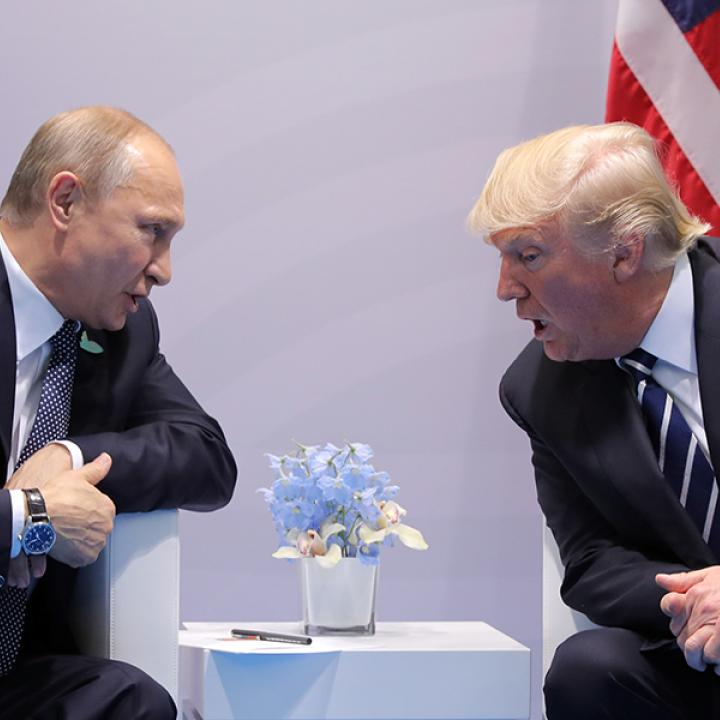
- Policy Analysis
- Articles & Op-Eds
It’s Time for Trump to Get Tough With Putin
Also published in Foreign Policy

The administration’s push to end the Ukraine war could bear fruit, but only if pressure is applied to both sides.
Practitioners of American statecraft have always used our leverage—positive and negative—to alter the behavior of others. For President Donald Trump, applying pressure on other countries and groups in order to advance U.S. interests comes very naturally. He’s done so with the Houthis in Yemen to stop their attacks on international shipping and on Israel—objectives that have not yet been achieved. The president is also applying U.S. leverage in a bid to end the war in Ukraine—which he’s described as a major priority. The problem is, so far Trump has been unwilling to apply the pressure evenly.
With Ukraine, Trump insisted on a deal in which the United States would gain access on very favorable terms to Ukraine’s rare-earth minerals. He actually suspended military and intelligence assistance to Ukraine. That suspension both limited Ukraine’s means to defend itself against Russian missiles and to resist Russian offensives in the areas around Kursk, where Ukrainian forces had penetrated and held Russian territory. The Institute for the Study of War pointed out that there was a “noteworthy" correlation between the suspension of U.S. intelligence sharing with Ukraine and the start of Russia’s collapse of the Ukrainian Kursk salient.
Pressuring the weaker party in a conflict, especially one that depended on our assistance, can work. Although Ukraine initially resisted a temporary cease-fire without security assurances, it gave in and accepted the Trump administration’s proposal. In return, the administration resumed military and intelligence assistance.
But pressuring the stronger party, the Russians, so far appears to be a different matter with Trump. By all appearances, Russian President Vladimir Putin wants to avoid saying no to Trump. But not saying no is not the same as saying yes. Putin said in principle a cease-fire is a good thing, but he then posed questions and conditions, including that the military assistance to Ukraine needed to stop and the Ukrainians could not rebuild their military—while, of course, no such conditions would apply to the Russians.
By getting Ukraine to accept the temporary cease-fire, Trump did, in the words of U.S. Secretary of State Marco Rubio, “put the ball” in Russia’s court. That was a form of putting subtle pressure on Putin and reflected a smart framing of the issue. Framing of issues so everyone has to respond to the United States is an important tool of statecraft and required Putin to figure out a way forward without alienating Trump. In response, Putin adopted the posture of saying “yes, but”—meaning he did not agree to the cease-fire but was willing for the two sides to halt attacks on each other’s energy infrastructure and end attacks in the Black Sea.
Whether this was a Russian concession is debatable at best. Before being willing to implement the truce in the Black Sea, the Russians want a series of sanctions lifted, including international banking restrictions with Russia reconnected to SWIFT—the global financial payment system. Even if Putin does move ahead with the deal, Russia would continue its military advance—retaking the Russian areas that Ukraine had captured—even as it gains an end to Ukrainian attacks on its oil infrastructure, which have been taking a toll.
If Trump truly wants to broker a peace agreement, at some point he must be prepared to impose a real price on Putin for saying no. The U.S. president did threaten this week to impose secondary tariffs on buyers of Russian oil if Putin blocks his bid to end the war in Ukraine. The tariffs, which Trump said could be as high as 50 percent, would hurt not just Russia but also its main oil customers, China and India.
Still, Trump has not been willing to put more direct, overt pressure on Putin to date. While it may be easier for Trump to exert leverage on Ukrainian President Volodymyr Zelensky, make no mistake, the United States has the ability to apply it to Putin. Russia has real vulnerabilities: It has suffered more than 700,000 dead and wounded, and, according to some estimates, it has lost a significant number of its armored forces; its economy is experiencing 21 percent interest rates and double-digit inflation; it has experienced a terrible brain drain; and its dependency on North Korean soldiers and Iranian drones and missiles is hardly a sign of strength. Putin’s ability to sustain the war for another year or two is not so clear—particularly if he understands from Trump that the consequence of a rejection is that the United States will commit to meeting Ukraine’s military and economic needs. The more Ukraine’s war effort is sustainable, the less time is on Putin’s side.
Put simply, if Trump wants to end the war, he will need to play hardball with Putin—and he has the means to do so. But Putin must believe it. He must believe that Trump is willing to continue to provide real support to Ukraine as a response to Putin’s unwillingness to make any meaningful concessions. In fact, he must believe that Trump will actually ratchet up what we provide to Ukraine. That is not a message Trump has sent to date, instead speaking only of possible sanctions on Russia—something that, at this point, is too vague to be compelling to Putin. But greater military backing for Ukraine coupled with Trump signaling that he will support using the $300 billion in frozen Russian assets for the Ukrainian economy and reconstruction could make a difference. Of course, Trump can also offer inducements—something that he seems prone to do with Putin. But in a case like this, where the stakes are high for Putin, it is what he stands to lose that will convince him that he needs to look for a way out.
Until now, Putin has not felt the need to do so. The irony is that Trump—if he is willing to apply real pressure and let Putin know our support for Ukraine will not change so long as he rejects an acceptable outcome—could actually be the one to produce an end to the war. It is important for Trump to have a clear picture of an acceptable or defensible peace—one in which, for example, Ukrainian sovereignty is not compromised, Kyiv can become a member of the European Union, the territorial adjustments are modest or the result of an internationally run referendum, and peacekeepers in Ukraine make the security assurances real. (And, should Russia violate any deal, NATO membership for Ukraine could be the response.) Coupled with that, Trump could offer Putin a lifting of the sanctions, a restoration of U.S. business in Russia, the unfreezing of Russian assets, adjustments to the size and location of NATO strike forces, etc.
In other words, Trump can use American leverage—combined with the Europeans, because they control the bulk of the frozen Russian assets—to achieve his objective of ending the war. He can marry U.S. objectives with U.S. means. For that to happen, for him to successfully conduct statecraft, he will have to apply our leverage not only to the weaker party but the stronger one as well.
Dennis Ross is the Davidson Distinguished Fellow at The Washington Institute and author of the new book Statecraft 2.0: What America Needs to Lead in a Multipolar World. This article was originally published on the Foreign Policy website.



